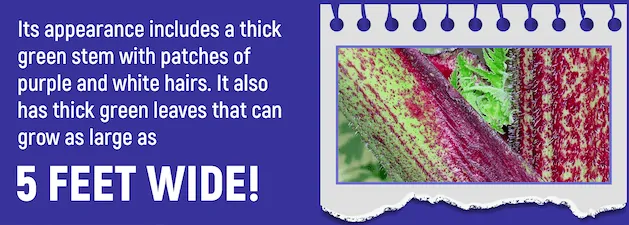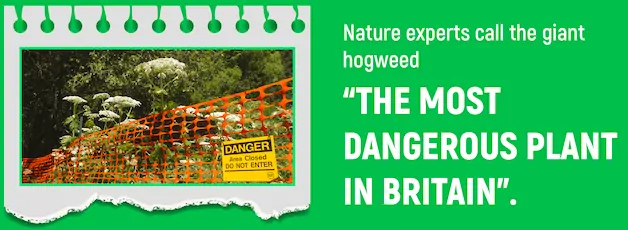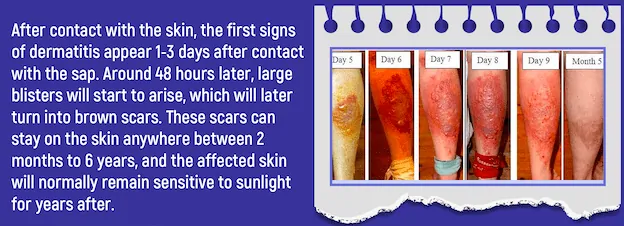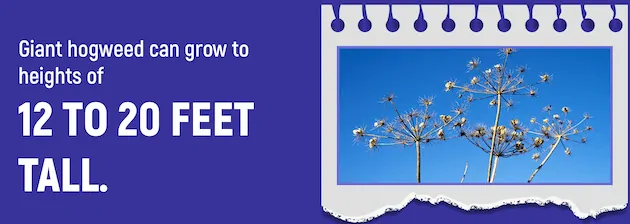When it comes to invasive, dangerous plants in the United Kingdom, giant hogweed is one of the worst offenders. Fast-spreading and harmful to human health, this member of the parsnip and carrot family first arrived on British shores in the 19th century, brought over from the Caucasus Mountains of Central Asia.
These days, as our Giant Hogweed Locations Map shows, the plant has spread all over the nation, gathering in especially large quantities around southern Scotland, the Midlands, and northern England too. This detailed guide will cover the answers to some common questions about giant hogweed (Heracleum mantegazzianum), giving you all the information you need to know about what it is, how to spot it, and what risks it can pose. If you have less time and just want the facts then take a look at our Giant Hogweed infographic.
Why is giant hogweed dangerous?
Giant hogweed has been referred to as “the most dangerous plant in Britain”, with leading British environmental agencies like the Scottish Natural Heritage, Natural Resources Wales, and the Environment Agency teaming up to track its spread and try to limit its growth, but what makes it so dangerous?
Well, the sap of this species of plant is the harmful part. It contains furocoumarins, which are organic chemical compounds produced by certain plants that are toxic to humans. If the sap gets into contact with someone’s skin, it seeps into the cells and prevents the skin from being able to protect itself against sunlight, leading to bad burns and scarring.
The sap is produced by little hairs along the stem and leaves of the plant, so it’s very easy for a person to accidentally brush up against it and suffer the side effects, which can be both short and long-term.
In the short-term, a person may suffer from blisters, rashes, irritation, and inflamed areas, which can be very painful. In the long-term, disfiguration, lasting purple blotches, and serious scarring can occur. What’s more, the affected areas can remain sensitive to sunlight for months or even years after the initial contact.
It’s worth noting that animals can suffer from these side effects too, and several dogs have been reported to have suffered harm and injury due to walking in hogweed-infested areas.
What do you do if you find giant hogweed?
If you encounter giant hogweed, the first thing to do is keep your distance. It only takes a slight touch to cause blisters and burns, and any contact between the hogweed and your body could lead to serious consequences. Children and pets should also be kept clear of the area, and you should watch your step, as the presence of one giant hogweed plant could indicate many more nearby.
If you or someone you know happens to make contact with the plant, be sure to wash the affected area as quickly as possible, seek medical advice, and try to get indoors and away from direct sunlight as quickly as possible to reduce the risk of burning.
Giant hogweed is found all over the UK, especially in areas near rivers or water sources, but also in simple home gardens and patches of forest or woodland too. Take a look at our interactive Giant Hogweed map to learn more about where this plant has been spotted, and if you find any plants we haven’t yet heard about, contact us and let us know some details, so we can keep the map updated.
How do you kill giant hogweed?
If you find giant hogweed in your gardens or on your land, you aren’t legally obligated to remote it, but it is often wise to try and do so. However, great care needs to be taken during this process. Simply trying to move or cut away these plants won’t work and could easily lead to injuries as their toxic chemicals are released into the air.
Instead, anyone wanting to kill giant hogweed should first equip themselves with some protective clothing, including a mask and gloves, and make sure that no bare skin is showing. With proper gear, you should be able to pull the plants right out of the ground, ideally in the late spring, before they flower.
Otherwise, strong weedkiller products may be used to get rid of them, but you have to be careful to avoid harming other plants or wildlife with these products.
You may also simply choose to ask a professional to deal with the plants on your behalf, rather than having to tackle it alone.
How do you identify giant hogweed?
One of the best ways to avoid suffering any issues as a result of giant hogweed is knowing what it looks like so you can easily identify it, both in your own garden and while out and about around the UK, and then take action to avoid it or get rid of it.
It looks quite similar to cow parsley, but is much larger, growing to a maximum height of around 5 metres or around 16 feet. Each of the plants can spread out to cover a range of around 1-2 metres too, so it’s basically like taking a piece of cow parsley and magnifying it enormously.
In the first year of its development, this species of plant forms a rosette of lobed leaves. In the summer months, small, white flowers in umbrella-shaped clusters form on the plant, facing upwards, and the stems tend to be green with purple spots and white hairs.
It can be easily confused with some other plants, like regular hogweed and cow parsley, but the key thing to remember is that giant hogweed is much bigger overall.
Can giant hogweed kill you?
The chances of an actual fatality occurring due to giant hogweed are relatively low. However, this plant is still very dangerous. The burns, blisters, and general skin damage it can cause can lead to serious pain and suffering, and excessive exposure to its toxic chemicals can make symptoms much worse.
If the sap of this species makes its way into someone’s eyes, it can lead to permanent blindness, and in children, the elderly, or those with pre-existing medical conditions, the complications caused by this giant weed can be very difficult to deal with.
Many people end up requiring hospitalisation as a result of their encounters with this species, so it has to be taken seriously.
What happens if you touch giant hogweed?
Touching giant hogweed is not recommended. It can be very dangerous and may cause severe physical issues to develop. As stated above, the leaves and stem of this plant are covered with little white hairs that produce sap. This substance is highly toxic to both humans and animals, and even just brushing up against hogweed plants or touching them lightly can allow the sap to enter your cells.
The sap has an immediate effect on human skin, making it much more sensitive to sunlight. It basically works in an opposite way to sun tan lotion, putting your skin at serious risk of burns and UV damage. Within a matter of hours, affected areas can suffer blisters and burns, and it can take days or weeks for these symptoms to fade away.
Not only that, but there are serious long-term risks associated with this invasive species of plant as well. The blisters can cause quite sizeable scars to develop, disfiguring large patches of a person’s body for years to come, and the affected areas can remain sensitive to sunlight for many months or even years after the initial contact too.
Why is the giant hogweed a problem?
The big issue with this invasive plant is the real risk it poses to people and animals. If a person comes into contact with the plant, the toxic sap along its leaves and stems can do some serious damage, leading to blisters, burns, scarring, and disfiguration. It can do a lot of harm to a single person with just the slightest contact, presenting a real risk to adults and children, especially those who might be unaware of how dangerous it really is.
Many people like to go for walks in beautiful woodland locations and rural trails across the UK, but this non native species is spreading fast and can turn a simple weekend walk into a real health crisis.
Another serious problem with this weed is how it can get out of control so quickly. It was first brought to Britain in the 19th century as an ornamental plant, but it didn’t take long at all for seeds to start spreading all over the nation. As our interactive Giant Hogweed Locations Map shows, this noxious weed can now be found all over the UK, in England, Scotland, Wales, and Northern Ireland.
It spreads quickly and grows tall and strong, making it difficult to deal with and competing with other forms of native wildlife too. A single mature hogweed plant can emit tens of thousands of seeds and giant hogweed is even finding its way into many gardens too, crowding out native flowers and putting people at risk.
What are the dangers of hogweed?
People who come into contact with giant hogweed can suffer from various issues as a result. Even just brushing a bare arm or leg up against the stems or leaves of this plant can lead to severe burning, blisters, and long-term scarring.
Small white hairs found along the stem of this invasive plant produce a kind of toxic substance, which interacts with human skin cells and makes them more sensitive to sunlight. So, within just a few hours of touching a leaf or stem, you can suddenly find yourself dealing with outbreaks of blisters and painful patches around your body.
These issues aren’t just painful in the short-term, they can last for years. Scars can form along arms, legs, and other affected areas of the body that might not fade for years to come, and many people who come into contact with this plant are left with blotchy purple patches too.
Giant hogweed also poses a real risk to local wildlife and native British flowers and plants. It can grow at an alarming rate, and a single plant can spawn thousands more, with each one able to grow over ten feet tall and prevent other local plants from surviving.




There’s a lot of it along the River Tees between Yarm and Stockton-On-Tees
Scores
Just got back from a walk by basselton beck, dogs were running happily until we see the sign. Didn’t know the dangers then, even the sign I thought it was minimal, terrified now!
Scores
If it’s that serious why can’t the government remove it when found straight away you should be able to report it and then they should remove it it sounds quite nasty
Scores
Great for beetles which eat pollen.
Scores